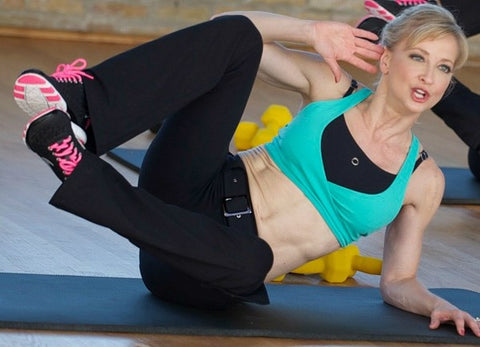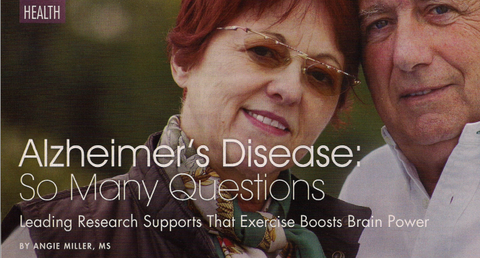by Angie Miller
When it comes to working out on a busy schedule, it's hard enough to fit in cardio, weights and stretching, much less spend more time trying to get enviably sculpted abs. With summer coming and swimsuit season around the corner, we’re all looking to tone up, trim down, and chisel our middle. Check out these four exercises from the Core & Pelvic Floor section of my Bedroom Body™ workout DVD, and you’ll be bikini ready in no time.

10-Minute abs workout: For each exercise, a mat or towel is the only equipment needed.
EXERCISE ONE: Oblique Crunch
Muscles worked: obliques, transverse abdominis (a deep abdominal muscle), glutes and adductors (inner thighs).

Start position: Start out on the mat on your side with your knees bent, placed slightly in front of your body. Keep your torso long and extended. Bend your bottom arm for support and place your elbow directly below your shoulder. Separate your knees into a clamshell position, placing the inside soles of your feet together. Bend your top arm at the elbow and rest your fingertips gently behind your ear. Engage your abdominals and lower back muscles.

Movement: Inhale first. As you exhale, lift your hips and bring your upper knee to your elbow, performing a side crunch. Focus on laterally flexing your spine and contracting through your obliques. Keep your torso strong and stable to avoid any extraneous upper-body movement and your head upright to avoid collapsing onto your shoulder.
Repetitions:
- Perform one set of 16 repetitions, single counts.
- Perform one set of 8 repetitions with pulses: up and pulse for three, lower down on four.
- Switch sides and repeat.
Note: If this move is too challenging, keep your knees together rather than separating them into a clamshell position. Once you master the clamshell move, you can make the exercise more intense by placing a small ball between your upper thighs. As you lift, squeeze and engage your inner thighs. This will also work your hip adductors.
EXERCISE TWO: Seated Clamshell Crunch
Muscles worked: rectus abdominis (the six-pack), adductors (inner thighs) and lower back.

Start position: Start in a seated position on your mat, facing front, with your knees bent and your hands on the floor behind your hips for support. Sit up tall with your torso long and extended, and your chest open. Keep the inside soles of your feet together and separate your knees. Lift your feet a few inches off the floor.

Movement: Inhale first. As you exhale, lift your legs and bring your knees toward your chest, performing an abdominal crunch. Focus on keeping your core strong and avoid collapsing through your torso or hiking up your shoulders. Think about driving your ribs into your hips as you exhale, engaging deep into your abdominals and lower back. Keep the movement isolated to your core and perform it slow and controlled.
Repetitions:
- Perform one set of 16 repetitions, single counts.
- Perform one set of 8 repetitions, with pulses: up and pulse for three, lower down on four.
EXERCISE THREE: Side Plank with Arm Extension
Muscles worked: obliques, transverse abdominis (a deep abdominal muscle), gluteus medius and adductors (inner thighs).

Start position: Start out on the mat on your side with your torso long and extended and your legs straight, stacked on top of one another. Bend your bottom elbow and place it directly below your shoulder, keeping your neck long and making sure there is space between your ear and your shoulder. Keep your shoulders and hips facing forward, stacked on top of one another. Your upper arm will be bent, with your elbow by your waist.

Movement: Engage your abdominals and lower back as you lift your hips and knees off the floor, extending your upper arm above your head. Your bottom foot should stay in contact with the floor as you lift, and your head should stay in line with your spine. Pause at the top, then lower down slow and controlled, bringing your elbow back to your waist. To avoid overloading your shoulder, keep your neck long and focus on lifting and engaging through your center.
Repetitions:
Perform 8 to 12 repetitions on each side.
Note: To make this exercise easier, bend your knees to make a shorter lever and put less stress on your shoulder. Another modification is to place your upper arm on the floor in front of you for additional support.
EXERCISE FOUR: Hip Lifts with Torso Rotation
Muscles worked: abdominals, lower back, gluteals and arms.

Start position: Start out seated on the mat with your knees bent and your feet hip-distance apart. Hands are behind your hips, placed flat on the mat for support. Your torso should be long and extended, and your head in line with your spine.

Movement: Inhale first. As you exhale, lift your hips off the floor, rotating your torso and extending your right arm to your left leg, fingertips to toes. In the upper extended position, you are supported only by your left hand and your right foot. Your balance and control comes from engaging through your center and stabilizing through your spine. Lower and switch to the other side.
Repetitions:
- Perform one set of 16 repetitions, alternating sides.
- Perform one set of 8 repetitions, slow and controlled; hold for a few seconds at the top, increasing the balance challenge.
Note: If this is too challenging, keep your hips on the floor and rotate your torso, extending your fingertips to your toes, still working your core, but without the additional balance challenge.
Best to You in Health
 Angie Miller is the star and creator of the Bedroom Body™ Workout and other top selling exercise DVD’s. Passionate about fitness and education, Angie teaches at Northern Illinois University and is a Certification Specialist for the Aerobic and Fitness Association of America (AFAA). She is a freelance writer, group fitness instructor, personal trainer, and proud mom. Learn more about Angie at: http://www.angiemillerfitness.com
Angie Miller is the star and creator of the Bedroom Body™ Workout and other top selling exercise DVD’s. Passionate about fitness and education, Angie teaches at Northern Illinois University and is a Certification Specialist for the Aerobic and Fitness Association of America (AFAA). She is a freelance writer, group fitness instructor, personal trainer, and proud mom. Learn more about Angie at: http://www.angiemillerfitness.com



















